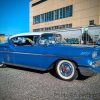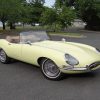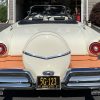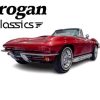1937 Jaguar
Description
This 1937 Jaguar SS100 was manufactured on November 26, 1937 and is one of approximately 116 3.5-liter examples produced. It was delivered new to its first owner in Argentina, where it reportedly remained until it was brought to California and acquired by the late owner in 1982. Finished in white over black with a black soft top, the car is powered by a numbers-matching inline-six mated to a replacement four-speed manual transmission and features twin SU carburetors, a fold-down windshield, 18″ wire wheels, hydraulic drum brakes, and a four-spoke steering wheel. The car is said to have been used primarily for local historic track day events over the past four decades, including runs at Laguna Seca and the Coronado Speed Festival. This SS100 is now offered as a running project by the seller on behalf of the late owner’s son with a Jaguar Heritage Trust Certificate, a tonneau cover, and a clean California title. Originally finished in Lavender Grey, the body of this example wears an older driver-quality repaint in white with a black soft top, and the hood has been modified to accommodate the exterior exhaust headers. The seller notes evidence of prior repairs to the front and rear fenders, and the condition of the body, lenses, and trim are shown up close in the gallery below. Factory 18″ wire wheels with knock-off spinners wear an older set of Michelin tires, and a matching spare is mounted on the rear bodywork. Hydraulic drum brakes from an XK120 were reportedly fitted, and the front suspension incorporates Andre-Hartford-type shock absorbers. The snap-on tonneau cover is shown fitted in the gallery. The cabin features reclining bucket seats upholstered in black along with matching door panels and carpets. The door panels, convertible top frame, and wood floor panels show heavy wear as depicted in the image gallery. The seller notes that the hand brake assembly and transmission tunnel cover are missing. A leather-wrapped four-spoke steering wheel fronts a body-colored dash housing chrome-ringed Smiths instrumentation including a 200-km/h speedometer and a tachometer with a 4,500-rpm redline, as well as gauges for oil pressure, engine temperature, voltage, and fuel level. The five-digit odometer shows just under 79k kilometers (~49k miles), although true mileage is unknown. The numbers-matching 3.5-liter inline-six is equipped with factory-style twin SU carburetors and an original-type distributor. A custom exhaust system has been fitted, and the firewall has been modified and the battery relocated to accommodate the brake booster. The seller notes that the wiring harness should be replaced and the engine is set up to run on an auxiliary fuel supply as the stock fuel tank will need to be cleaned before use. A cold-start video can be viewed here. Engine block stamping M516E matches the engine number displayed on the chassis data plate and on the Jaguar Heritage Trust Certificate shown below. Power is sent to the rear wheels through a replacement four-speed manual transmission that is said to have been installed in Argentina. Additional photos of the underside are provided in the image gallery below. The Jaguar Heritage Trust Certificate lists a build date of November 26, 1937 and displays the factory colors along with the chassis, body, and engine numbers.








































